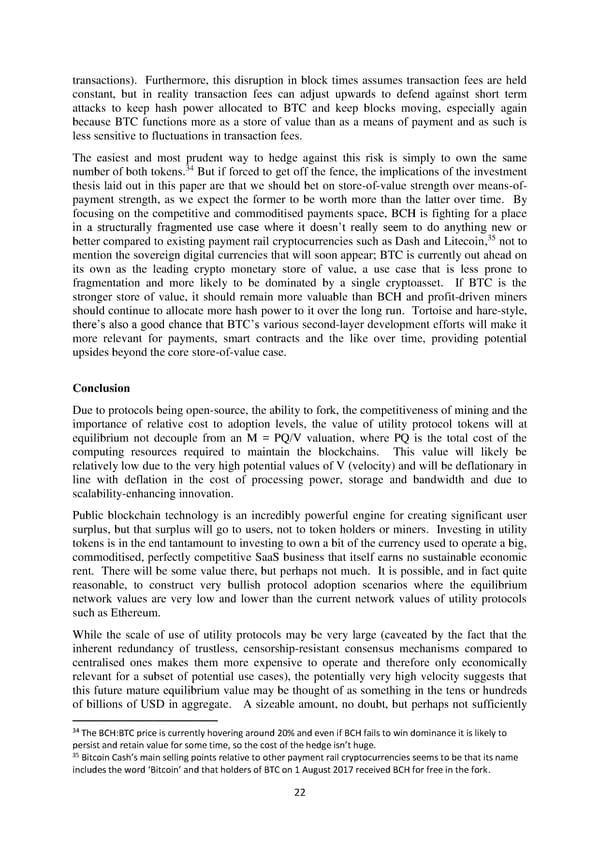transactions). Furthermore, this disruption in block times assumes transaction fees are held constant, but in reality transaction fees can adjust upwards to defend against short term attacks to keep hash power allocated to BTC and keep blocks moving, especially again because BTC functions more as a store of value than as a means of payment and as such is less sensitive to fluctuations in transaction fees. The easiest and most prudent way to hedge against this risk is simply to own the same number of both tokens.34 But if forced to get off the fence, the implications of the investment thesis laid out in this paper are that we should bet on store-of-value strength over means-of- payment strength, as we expect the former to be worth more than the latter over time. By focusing on the competitive and commoditised payments space, BCH is fighting for a place in a structurally fragmented use case where it doesn’t really seem to do anything new or better compared to existing payment rail cryptocurrencies such as Dash and Litecoin,35 not to mention the sovereign digital currencies that will soon appear; BTC is currently out ahead on its own as the leading crypto monetary store of value, a use case that is less prone to fragmentation and more likely to be dominated by a single cryptoasset. If BTC is the stronger store of value, it should remain more valuable than BCH and profit-driven miners should continue to allocate more hash power to it over the long run. Tortoise and hare-style, there’s also a good chance that BTC’s various second-layer development efforts will make it more relevant for payments, smart contracts and the like over time, providing potential upsides beyond the core store-of-value case. Conclusion Due to protocols being open-source, the ability to fork, the competitiveness of mining and the importance of relative cost to adoption levels, the value of utility protocol tokens will at equilibrium not decouple from an M = PQ/V valuation, where PQ is the total cost of the computing resources required to maintain the blockchains. This value will likely be relatively low due to the very high potential values of V (velocity) and will be deflationary in line with deflation in the cost of processing power, storage and bandwidth and due to scalability-enhancing innovation. Public blockchain technology is an incredibly powerful engine for creating significant user surplus, but that surplus will go to users, not to token holders or miners. Investing in utility tokens is in the end tantamount to investing to own a bit of the currency used to operate a big, commoditised, perfectly competitive SaaS business that itself earns no sustainable economic rent. There will be some value there, but perhaps not much. It is possible, and in fact quite reasonable, to construct very bullish protocol adoption scenarios where the equilibrium network values are very low and lower than the current network values of utility protocols such as Ethereum. While the scale of use of utility protocols may be very large (caveated by the fact that the inherent redundancy of trustless, censorship-resistant consensus mechanisms compared to centralised ones makes them more expensive to operate and therefore only economically relevant for a subset of potential use cases), the potentially very high velocity suggests that this future mature equilibrium value may be thought of as something in the tens or hundreds of billions of USD in aggregate. A sizeable amount, no doubt, but perhaps not sufficiently 34 The BCH:BTC price is currently hovering around 20% and even if BCH fails to win dominance it is likely to persist and retain value for some time, so the cost of the hedge isn’t huge. 35 Bitcoin Cash’s main selling points relative to other payment rail cryptocurrencies seems to be that its name includes the word ‘Bitcoin’ and that holders of BTC on 1 August 2017 received BCH for free in the fork. 22
 Investor’s Take on Cryptoassets by John Pfeffer Page 21 Page 23
Investor’s Take on Cryptoassets by John Pfeffer Page 21 Page 23